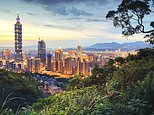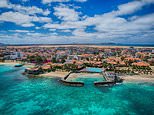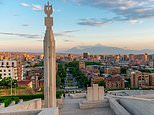
‘I feel proud to be Taiwanese,’ says my tour guide, Yvonne. ‘Not everyone does. But I do.’
A thousand-odd metres above sea level, we’re sitting in the Saiji Tea House in Taiwan’s Alishan Mountains sipping cups of oolong tea as mist blankets the valley below.
It’s easy to understand her national pride.
I’m spending a week in Taiwan, travelling from the capital Taipei, in the north, down to the southernmost province, with plenty of stop-offs in between.
Yet despite the country’s abundant offerings, Taiwan has long been largely overlooked by Western tourists.
While Japan and South Korea welcome 36.9 million and 16.4 million international visitors respectively every year, Taiwan is far behind with a mere 7.85 million, including a paltry 65,000 Britons – but interest is booming, with tourist rates close to eclipsing those pre-pandemic.
With direct Heathrow flights from £730 on China Airlines and a plethora of interesting cultural sights, buzzing cities and great food – and distinctly less overcrowding than in other parts of Asia – this subtropical island is set to hit the big time.
We begin our trip in Taipei, the northernmost city, and as of 1949 (after the end of Japanese rule in 1945), Taiwan’s capital. It’s a lively place – with the buzz of Tokyo but without its rigidity. People are notably friendly as we tour the streets.
The Mail’s Executive Travel Editor Genie Harrison visits the subtropical islad of Taiwan, to find out why it’s Asia’s fastest growing hotspot
Genie samples some of the culinary delights of Taiwan’s foodie hotspot,Tainan
Taiwan is home to to a plethora of natural wonders, including the Alishan Mountains and the Alishan Forest, some 1000m above sea level
First on our itinerary is Ximending: Taipei’s answer to Times Square, where visitors stop traffic to take photos on the rainbow-coloured crossing.
Taiwan is renowned for its progressive attitude towards LGBTQ+ communities; it became the first Asian country to legalise same-sex marriages in 2019, and is home to the continent’s largest annual Pride celebration.
But as we come to learn, Taiwanese self-determination was not always a given.
We visit the impressive Chiang Kai Shek Memorial Hall, and guide Yvonne explains the decades Taiwan (officially the Republic of China) spent under rule by the Dutch, China, and finally the Japanese.
‘It’s quite a sad history,’ she concedes.
But today, there’s an optimistic feel to Taiwan that moves beyond its tragic past – even if the threat of invasion from China, which disputes its nationhood, continues to loom.
A few hours’ drive from Taipei, Sun Moon Lake takes its name from its formation: its eastern half is rounded like the sun, while the western end curves into a crescent moon.
It’s a far cry from the rush of Taipei, and there are few other boats on the blue-green water as we cruise across.
First on Genie’s itinerary is Ximending, Taipei’s answer to Times Square, where visitors stop traffic to take photos on the rainbow-coloured crossing. Taiwan is renowned for its progressive attitudes towards LGBTQ+ communities, and hosts Asia’s biggest Pride celebration every year
There are 16 different indigenous communities in Taiwan, 2.6 per cent of the overall population, and one of these tribes, the Thao, live in the region surrounding the lake.
Accordingly, we make a lunch stop at indigenous restaurant, Lu Thao, run by an award-winning chef and Thao community member.
The food is like nothing I’ve eaten before – and is distinct, also, from the Taiwanese cuisine we’ve sampled so far on our trip.
As we tuck in, Yvonne explains how the Lalu Island, at the centre of the lake, is considered a sacred site for the tribe, where the sprits of their ancestors reside.
Looking over the tranquil water the following morning from the Lalu Hotel, you can’t help but feel a sense of that spirituality.
The lushness of Taiwan’s natural environment continues to impress as we head to Alishan Forest: 2,500m high, and surrounded by what translates from Chinese as a ‘sea of clouds’.
We traverse the forest trails in light rain, admiring the cypresses and cedars as well as three generations of trees that have grown intertwined with one another.
While autumn brings soft greens to the alpine area, Alishan is also a great place to admire cherry blossom and wisteria during the spring.
Genie visits Taiwan’s Sun Moon Lake, home to one of the country’s 16 indigenous communities, the Thao tribe
The forest is home to its own 85-kilometre railway, built originally by the Japanese in 1912 for logging, but today a favourite attraction for visitors to the area.
Food plays a vital role in Taiwanese culture – so much so locals don’t ask ‘how’ someone is by way of greeting, but instead: ‘have you eaten yet?’
The diversity of the culinary offerings is eye-opening: we try everything from oyster omelettes in Taipei’s Shinlin Night Market to rainbow-coloured noodles in the countryside of Gaoshu, a southern province.
It’s Tainan, though, that stands out as Taiwan’s foodie destination. After visiting a Confucian Temple – the country’s oldest – we head to restaurant Po Jen Tang.
A hundred years ago, this same space functioned as a Chinese medicine shop, and the sixth-generation owner has intentionally kept the apothecary cabinets.
Underneath the glass-topped dining tables are inscribed plaques from the shop’s heyday, and atop the shop counter is a bronzed acupuncture model.
The food comprises a variety of broths and teas on the set menu, including ‘happy’ and ‘sleep well’ tea, as well as a delicious chicken broth that’s supposedly good for the liver.
The flavours are faintly medicinal but tasty, and you can’t help but leave feeling nourished.
Taiwan is the birthplace of bubble tea: a cold drink, usually made with a tea or milk base (although fruitier options are on offer), and chewy tapioca pearls
In an antidote to healthy living, though, Taiwan has plenty to please those with a sweet tooth. This is, after all, the birthplace of bubble tea: a cold drink, usually made with a tea or milk base (although fruitier options are on offer), and chewy tapioca pearls.
While its precise origin remains up for debate (ownership is claimed by two rival stores), bubble tea is thought to have been invented in the 1980s: during summer months, when hot tea was not to everyone’s taste, shop owners began experimenting with cold brews, and added tapioca to the traditional drink.
There’s no shortage of the stuff during our trip, acting as a welcome refreshment to Taiwan’s subtropical climate.
However, the variety we try in Tainan’s Hanlin Tea House, one of the supposed original sites, is particularly delicious.
We spend a final morning in the country down south, watching purple crow butterflies float along the Maolin Butterfly Trail.
Before we leave the visitor centre though, the receptionist stops our tour group in a bid to get a photo. ‘He wants to prove that Western tourists have made it here,’ Yvonne explains.
He seems positively thrilled by our presence. But it’s a joy to be here, wandering along the paths and spotting the different species of butterfly along the paths and among the trees.
TRAVEL FACTS
A 14-day ‘Treasures of Taiwan’ tour starts from £3,950pp including return flights, B&B accommodation, transfers, private tours and an expert driver and guide (bambootravel.co.uk). More information: eng.taiwan.net.tw.
Source link
CHECK OUT: Top Travel Destinations
READ MORE: Travel News



